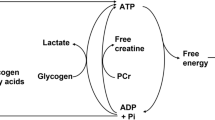Abstract
The adaptation of cardiac oxidative phosphorylation to changing cardiac work load has been investigated in many ways, but the precise regulatory mechanisms are still unknown. Our laboratory has focused on the time course of the first phase of the response of cardiac oxidative phosphorylation and high-energy phosphates in response to quick changes in cardiac workload. 1,2 To quantitate the time course of the response of oxidative phosphorylation to changed ATP hydrolysis, we determine the response time of cardiac mitochondrial oxygen consumption (tmito ), by correcting the response of coronary venous oxygen concentration for diffusion and intravascular delays and for oxygen dissociation from myoglobin.1
Access this chapter
Tax calculation will be finalised at checkout
Purchases are for personal use only
Preview
Unable to display preview. Download preview PDF.
Similar content being viewed by others
References
Van Beek JHGM, Westerhof N. Response time of cardiac mitochondrial oxygen consumption to heart rate steps. Am J Physiol 1991; 260: H613–H625.
Eijgelshoven MHJ, van Beek JHGM, Mottet I, Nederhoff MGJ, van Echteld CJA, Westerhof N. Cardiac high-energy phosphates adapt faster than oxygen consumption to changes in heart rate. Circ Res 1994; 75:751–759.
From AHL, Zimmer SD, Michurski SP, Mohanakrishnan P, Ulstadt VK, Thoma WJ, Uğurbil K. Regulation of the oxidative phosphorylation rate in the intact cell. Biochemistry 1990; 29: 3731–3743.
Laughlin MR, Taylor J, Chesnick AS, DeGroot M, Balaban RS. Pyruvate and lactate metabolism in the in vivo dog heart. Am J Physiol 1993; 264: H2068–dyH2079.
Scholz TD, Laughlin MR, Balaban RS, Kupriyanov VV, Heineman FW. Effect of substrate on mitochondrial NADH, cytosolic redox state, and phosphorylated compounds in isolated hearts. Am J Physiol 1995; 268:H82–H91.
Koretsky AP, Balaban RS. Changes in pyridine nucleotide levels alter oxygen consumption and extra-mito-chondrial phosphates in isolated mitochondria: a 3IP-NMR and NAD(P)H fluorescence study. Biochim Biophys Acta 1987; 893: 398–408.
Zimmer SD, Uğurbil K, Michurski SP, Mohanakrishnan P, Ulstadt VK, Foker JE, From AHL. Alterations in oxidative function and regulation in the post-ischemic myocardium. J Biol Chem 1989; 264: 402–411.
Kobayashi K, Neely JR. Control of maximum rates of glycolysis in rat cardiac muscle. Circ Res 1979; 44: 166–175.
Chapman JB. Fluorometric studies of oxidative metabolism in isolated papillary muscle of the rabbit. J Gen Physiol 1972; 59: 135–154.
Williamson JR. Glycolytic control mechanisms: I. Inhibition of glycolysis by acetate and pyruvate in the isolated perfused rat heart. J Biol Chem 1965; 240: 2308–2321.
Hak JB, van Beek JHGM, van Wijhe MH, Westerhof N. Influence of temperature on the response time of mitochondrial oxygen consumption in isolated rabbit heart. J Physiol (London) 1992; 447:17–31.
Van Beek JHGM, Tian X, Zuurbier CJ, de Groot B, van Echteld CJA, Eijgelshoven MHJ, Hak JB. The dynamic regulation of myocardial oxidative phosphorylation. Analysis of the response time of oxygen consumption. Moll Cell Biochem. In press.
Snedecor GW, Cochran WG. Statistical Methods. Seventh Edition. Ames: Iowa State University Press; 1980.
Van Beek JHGM, Bouma P, Westerhof N. Oxygen uptake in saline-perfused rabbit heart is decreased to a similar extent during reductions in flow and in arterial oxygen concentration. Pflügers Arch. 1989; 414: 82–88.
Mootha VK, Arai AE, Balaban RS. Maximum oxidative phosphorylation capacity of the mammalian heart. Am J Physiol 1997; 272: H769–H775.
Van Beek JHGM, Hak JB, van Wijhe MH, Westerhof N. The control exerted by oxidative phosphorylation on respiration in the intact heart. In: Westerhoff HV, Snoep JL, Wijker JE, Sluse FE, Kholodenko BN, editors. Biothermokinetics of the Living Cell. Amsterdam: BioThermoKinetics Press; 1996, 119–123.
Van Beek JHGM, Hak JB, van Wijhe MH, Eijgelshoven MHJ, Westerhof N. The myocardial mitochondrial aerobic capacity is partially limiting for cardiac oxygen consumption and contractility [Abstract]. Pflügers Arch (Europ J Physiol) 1995; 430 Suppl 4: R9.
De Groot B, Dijk FJ, van Beek JHGM. Response of cardiac respiration to steps in heart rate in not slowed after reduction of mitochondrial capacity in normal and pressure overloaded hearts [Abstract]. Proceedings of the International Union of Physiological Sciences, XXXIIIrd Congress, St Petersburg. 1997; (P063.06).
Zuurbier CJ, van Beek JHGM. Mitochondrial response to heart rate steps in isolated rabbit heart is slowed after myocardial stunning. Circ Res 1997; 81:69–75.
Harrison GJ, de Groot B, van Wijhe MH, Zuurbier CJ, van Beek JHGM. On the importance of creatine kinase for metabolic response times during rapidly increased work loads in isolated rabbit heart. Proceedings of the International Union of Physiological Sciences, XXXIIIrd Congress, St Petersburg. 1997; (P063.01).
Author information
Authors and Affiliations
Corresponding author
Editor information
Editors and Affiliations
Rights and permissions
Copyright information
© 1998 Springer Science+Business Media New York
About this chapter
Cite this chapter
Tian, X., van Beek, J.H.G.M. (1998). Response Time of Myocardial Oxygen Consumption to Cardiac Work Jumps at 28°C Varies with Exogenous Carbon Substrate. In: Hudetz, A.G., Bruley, D.F. (eds) Oxygen Transport to Tissue XX. Advances in Experimental Medicine and Biology, vol 454. Springer, Boston, MA. https://doi.org/10.1007/978-1-4615-4863-8_60
Download citation
DOI: https://doi.org/10.1007/978-1-4615-4863-8_60
Publisher Name: Springer, Boston, MA
Print ISBN: 978-1-4613-7206-6
Online ISBN: 978-1-4615-4863-8
eBook Packages: Springer Book Archive




